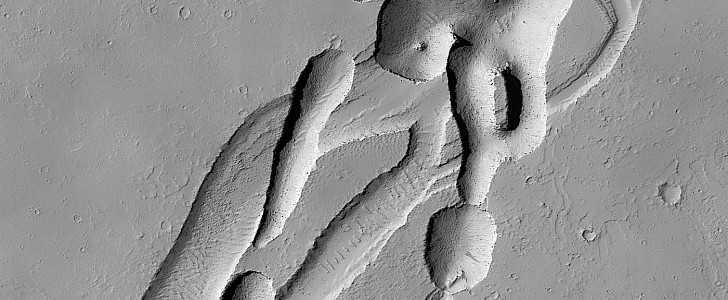Mars is both a place to dream about, as it is the first, and so far the only full-blown planet we humans are targeting for a visit, but also one of wonder, given the large number of mysteries that still surround it, and the large number of strange features we keep discovering.
Case in point, this… thing we have here, a natural formation that includes a variety of channels, pits and fractures. Taken separately, each of these features is not something we haven’t seen before on Mars, but here they come together to form something scientists call a “complicated area.”
“Here” would be in an area near the Olympica Fossae formation in the Tharsis quadrangle. Olympica stretches for about 420 km (261 miles) and contains the remnants of flowing lava and even flowing water.
The image we have here was taken back in 2016 with the HiRISE camera in orbit around the planet, from an altitude of 278 km (173 miles), and shows the above-mentioned features intersecting each other to form something that looks like an abstract surface sculpture.
There is no exact answer as to what caused this intricate and chaotic pattern, but scientists from NASA and the University of Arizona, who are running the HiRISE, say we may be looking at collapsed lava tubes “where overlying rock “drained” into voids created by extensional faulting.”
Even though their origin is a bit of a mystery, we’re told there is one thing we can tell about these features from this photo: chronology.
The relative ages of the pits and channels can be deduced based on which ones cross-cut others, as we have the older channels appearing as smooth-edged and shallow, while the newer ones as deeper and more sharp-edged.
Knowing which came last could of course help us date these features, and that could give us a better understanding on when Mars was still geologically active.
“Here” would be in an area near the Olympica Fossae formation in the Tharsis quadrangle. Olympica stretches for about 420 km (261 miles) and contains the remnants of flowing lava and even flowing water.
The image we have here was taken back in 2016 with the HiRISE camera in orbit around the planet, from an altitude of 278 km (173 miles), and shows the above-mentioned features intersecting each other to form something that looks like an abstract surface sculpture.
There is no exact answer as to what caused this intricate and chaotic pattern, but scientists from NASA and the University of Arizona, who are running the HiRISE, say we may be looking at collapsed lava tubes “where overlying rock “drained” into voids created by extensional faulting.”
Even though their origin is a bit of a mystery, we’re told there is one thing we can tell about these features from this photo: chronology.
The relative ages of the pits and channels can be deduced based on which ones cross-cut others, as we have the older channels appearing as smooth-edged and shallow, while the newer ones as deeper and more sharp-edged.
Knowing which came last could of course help us date these features, and that could give us a better understanding on when Mars was still geologically active.






